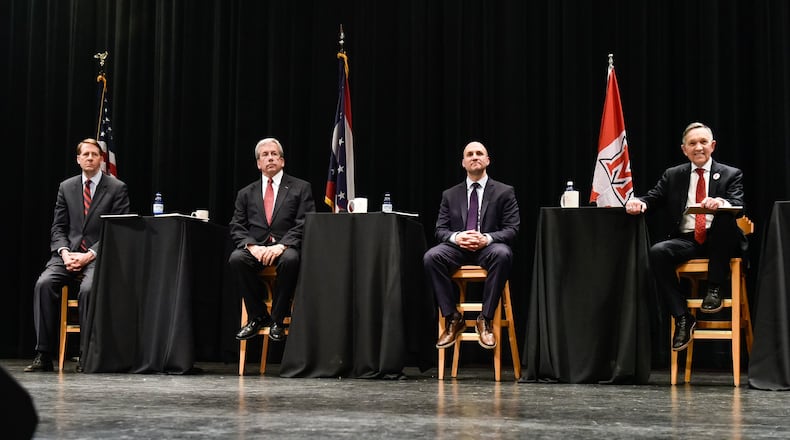RELATED: Ohio House Speaker Cliff Rosenberger resigning amid FBI probe
The Democrats running for governor are former federal consumer protection chief and former Ohio attorney general Richard Cordray; former Congressman Dennis Kucinich; former Ohio Supreme Court Justice William O’Neill; and state Sen. Joe Schiavoni.
“(The candidates) may have missed an opportunity to distinguish themselves from the field and build momentum,” said Miami University political science professor John Forren, who called it an “informative policy-focused” debate. “Cordray and Kucinich came into the debate with clear advantages in terms of statewide name recognition and established support. And nothing happened to change that.”
Cordray tried to establish himself as the most experienced candidate, having won two statewide elections as treasurer and attorney general. He said the next governor has to “stand proudly on progressive issues,” including moving forward on workforce development and small-business support.
RELATED: Payday lending bill comes to life as House speaker faces probe
O’Neill focused a lot of attention during the debate on legalizing marijuana and reopening mental health hospitals but made one of the biggest mistakes of the night when asked about the long-troubled Brent Spence Bridge project, which carries Interstates 75 and 71 over the Ohio River in Cincinnati.
Credit: Nick Graham
Credit: Nick Graham
“I don’t know about your bridge,” he flatly told moderator Sheree Paolello. “I’m sure I’ve been over it many times … but I don’t know about your bridge.”
VOTERS GUIDE: Compare the Democratic governor candidates on the issues
Kucinich, a former Cleveland mayor, said the state needs to focus on rebuilding infrastructure — and said his first act as governor would be to break ground on rebuilding the Western Hills Viaduct in Cincinnati — and health care for all. Kucinich also said while he disagrees with President Donald Trump on most things, he agrees with him on trade issues, such as getting out of NAFTA.
Kucinich also bragged about his “F” rating with the National Rifle Association, separating himself from Cordray, who holds an “A” rating from the organization. Asked if he would support an assault rifle ban, Cordray didn’t directly answer but said there needs to be a comprehensive approach to curbing gun violence. Kucinich said he supported such a ban.
Credit: Nick Graham
Credit: Nick Graham
Schiavoni would also back a bill banning on assault weapons if he became governor. The youngest of the candidates, the 38-year-old Schiavoni said he was tired of Democrats putting up the same candidates.
“We need a candidate who is fresh, passionate,” he said.
The candidates also spent time talking about the opioid crisis that’s arguably hit Ohio harder than any other state in the country. The number of people dying from opioid overdose has increased statewide year-over-year for the past several, just as it has in many counties, such as Butler and Hamilton counties.
RELATED: GOP’s Warren Davidson: Kucinich would be better governor than Cordray
Schiavoni said he would allocate 10 percent of the $2 billion rainy day fund to education, law enforcement, and addiction services and mental health. He also said this is a personal issue as the sister of his running mate, State Board of Education member Stephanie Dodd, died because of an opioid overdose.
“This isn’t about throwing away people,” Schiavoni said. “Most of the people dealing with addiction took the drug exactly like the doctor told them to.”
Kucinich said the opioid epidemic “is the one issue that is devastating families,” and there has to be support. He’s also in favor of sending non-violent, low-level drug offenders to treatment over prison.
“We have to be compassionate with this, and also wise,” he said.
VOTERS GUIDE: Compare the Republican governor candidates on the issues
Cordray puts a lot of the blame for the rising death tolls on Republicans in office, saying “they’ve done nothing effective to address this crisis.”
“They ignored it for a number of years and wished it to go away, so it’s on their watch,” he said.
Credit: Nick Graham
Credit: Nick Graham
He also said Ohio cannot “arrest its way out of the crisis” and needs “robust” prevention and treatment programs.
“That’s the only way we will solve this problem in Ohio,” Cordray said.
O’Neill, a former emergency room nurse, said the state needs more psychiatric hospitals and fewer prisons. He also said legalizing marijuana is also important to fight this epidemic.
“We need to legalize marijuana which will, by the Colorado model, reduce heroin use by 25 percent, will reduce heroin deaths by 25 percent. That’s 1,000 people a year that don’t die,” he said.
While it's not the 25 percent O'Neill said Tuesday night, an American Journal of Public Health article indicates preliminary reports show since Colorado's 2014 legalization of marijuana opioid-related deaths have dropped by more than 6 percent, according to The Washington Post.
Ohio Democratic Party Chairman David Pepper said Tuesday’s debate was a win for Democratic Party voters.
Credit: Nick Graham
Credit: Nick Graham
“I’m proud that we have candidates who are willing to stand in front of the voters and answer questions that are unscripted, and it’s a real contrast to the other side where Mike DeWine has spent years ducking debates which I think is a disservice,” he said.
On the Republican side, Attorney General Mike DeWine is seeking his party’s nomination against Lt. Gov. Mary Taylor, who has also criticized the former U.S. senator for not praticipating in debates.
The two did talk to reporters at Miami University Regionals campus in Hamilton last week, and the video from that discussion will air Wednesday evening on Journal-News.com.





